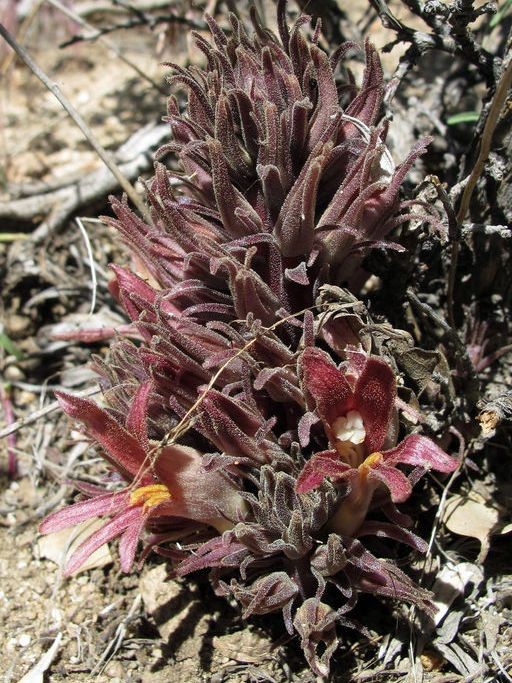Hillside broomrape
(Aphyllon vallicolum)

Description
Orobanche vallicola is a species of broomrape known by the common name hillside broomrape. It is endemic to California, where it is an uncommon member of the flora in forests and woodlands.Orobanche vallicola is a parasite growing attached to the roots of other plants, generally Sambucus species. The plant produces a thick, hairy, glandular pinkish stem up to about 40 centimeters tall. As a parasite taking its nutrients from a host plant, it lacks leaves and chlorophyll. The inflorescence is a cluster or branching array of flowers. Each tubular flower is up to 3 centimeters long, yellowish to pinkish and red-veined in color. Broomrapes are generally small, only 10–60 centimetres (4–24 inches) tall depending on species. They are best recognized by the yellow- to straw-coloured stems completely lacking chlorophyll, bearing yellow, white, or blue snapdragon-like flowers. The flower shoots are scaly, with a dense terminal spike of 10-20 flowers in most species, although single in one-flowered broomrape (Orobanche uniflora). The leaves are merely triangular scales. The seeds are minute, tan or brown, blackening with age. These plants generally flower from late winter to late spring. When they are not flowering, no part of the plants is visible above the surface of the soil. As they have no chlorophyll, the broomrapes are totally dependent on other plants for nutrients. Broomrape seeds remain dormant in the soil, often for many years, until stimulated to germinate by certain compounds produced by living plant roots. Broomrape seedlings put out a root-like growth, which attaches to the roots of nearby hosts. Once attached to a host, the broomrape robs its host of water and nutrients. Some species are only able to parasitise a single plant species, and they are often named after the plant they parasitise, such as ivy broomrape (O. hederae) being restricted to parasitising ivy. Others can infect several genera, such as the lesser broomrape O. minor, which lives on clover and other related Fabaceae. Branched broomrape Orobanche ramosa, native to central and southwestern Europe but widely naturalised elsewhere, is considered a major threat to crops in some areas. Plants that it targets are tomato, eggplant, potato, cabbage, coleus, bell pepper, sunflower, celery, and beans. In heavily infested areas, branched broomrape can cause total crop failure.
Taxonomic tree:







